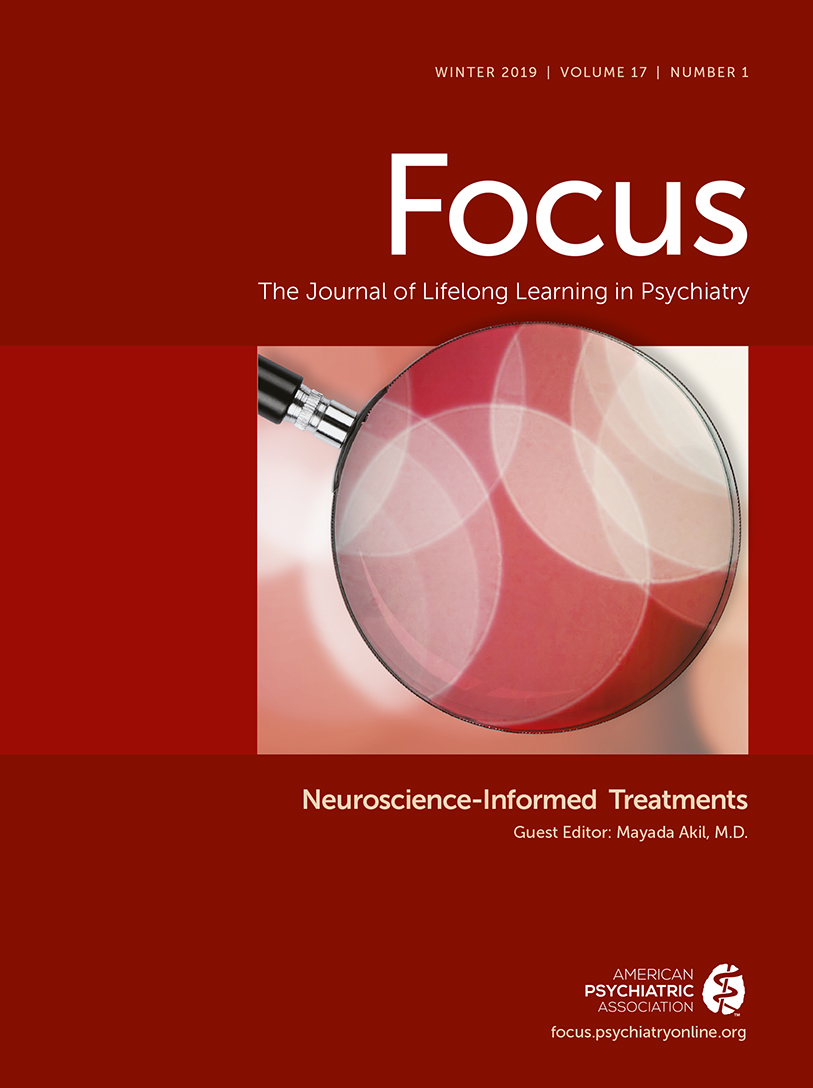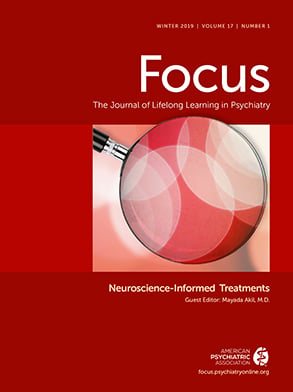This exercise is designed to test your comprehension of material relevant to this issue of Focus as well as your ability to evaluate, diagnose, and manage clinical problems. Answer the questions to the best of your ability with the information provided, making your decisions as if the individual were one of your patients.
Questions are presented at “consideration points” that follow a section providing information about the case. One or more choices may be correct for each question; make your choices on the basis of your clinical knowledge and the history provided. Read all of the options for each question before making any selections. You are given points on a graded scale for the best possible answers, and points are deducted for answers that would result in a poor outcome or delay your arrival at the right answer. Answers that have little or no impact receive zero points. At the end of the exercise, you will add up your points to obtain a total score.
Case Vignette
Winifred Jones is a 62-year-old woman who was referred to you by her primary psychiatrist for a second-opinion consultation, because she had not responded adequately to several trials of medications for recurrent major depressive disorder and is markedly depressed.
The referral documents you received described briefly that she had first sought care for depression at age 32, after the birth of her son. At that time, she had tried several tricyclic antidepressants and lithium before a trial of selegiline led to remission. She continued this medication, and her remission lasted until approximately 4 years ago, when she reported awakening one morning and feeling that “the depression had returned,” with depressed mood, anhedonia, agitation, insomnia, loss of appetite, and guilty ruminations. A physical examination at that time revealed a slightly underweight middle-aged woman with no other abnormalities. Her records indicate that no psychosocial or environmental trigger could be identified for the return of depressive symptoms.
Over the past several years, she has tried a long list of medications with her primary psychiatrist. She has had trials of at least four weeks’ duration at a therapeutic dose of fluoxetine, sertraline, duloxetine, bupropion, bupropion plus venlafaxine, mirtazapine, lamotrigine, lamotrigine plus aripiprazole, lamotrigine plus methylphenidate, and escitalopram alone and then augmented with lurasidone. None of these trials yielded more than 10% improvement on the Patient Health Questionnaire–9 (PHQ-9) scales that had been collected periodically by her psychiatrist over these medication trials.
Consideration Point A
On the basis of what you know of the patient’s history at this point, which of the following statements applies to a possible diagnosis or diagnoses?
A.1
Recurrent unipolar, major depressive disorder
A.2
Treatment-resistant depression
A.3
Depression associated with Parkinson’s disease
A.4
Depression in bipolar disorder
Case Vignette Continues
When the patient came to your office for further assessment, she provided more details about her recent and remote past history. She confirmed that the medication trials had all been marked by inefficacy rather than by intolerability. She confirmed that she is otherwise physically healthy, although she has been slightly underweight for several years; she attributed this to low appetite as part of her depression. Her PHQ-9 score that day was 21.
She shared that she was working as a self-employed jewelry maker. She had been unable to pay the premiums on her disability insurance, so the policy had lapsed several years before, and she had limited financial reserves. For 25 years, she has been the primary caretaker for her son, who suffered an anoxic brain injury in childhood and was dependent on others for many self-care activities. Her husband had died 18 months ago in a car accident. Her sister and brother live in another state, so she is without local family support, but she does have several close friends in town who have given her an occasional respite from caring for her son.
On examination, the patient was pleasant and cooperative, casually attired in monochromatic shades of grays and blacks. Moderate psychomotor agitation was noted, with an excess of spontaneous movement, with hand wringing and frequent shifting in her chair. Eye contact was adequate. Speech was of a somewhat rapid rate but of normal volume and prosody. Affect was anxious, sad, and depleted of energy. She characterized her mood as, “I’m so sad . . . I’m pretty hopeless that I’ll ever feel well again.” Her thought process was of normal rate and organization. Her thought content was free of hallucinations or current suicidal or homicidal intent; she denied any intention or plan of suicide or other self-injurious behaviors. Cognitively, she was awake, alert, and oriented to person, place, date, and circumstances. Memory registration was intact with three out of three stimuli, and recall after delay was two out of three items. She was able to spell the word world forward and backward, accurately but slowly. She had no difficulty repeating the phrase “no ifs, ands, or buts.” Her insight was intact in that she recognized that her depression was exacerbating her doubts about recovery and that she needed effective treatment. Her judgment was intact in that she was seeking care and was able to weigh the risks and benefits of additional treatments. No tremors or involuntary movements were noted. Her gait was unremarkable.
You suggested that next-step treatment options included a trial of transcranial magnetic stimulation (TMS), a trial of electroconvulsive therapy (ECT), and a trial of ketamine. Traveling to the nearest TMS provider would require her to drive for over an hour each way for the weeks of treatment, which she said was not feasible given that she was still needing to make and sell her jewelry creations and help her son. Likewise, she understood the high probability of improved symptoms with ECT, but restrictions on driving were problematic as the caregiver for her disabled son.
She was eager to learn more about ketamine.
Consideration Point B
In your discussion of the use of ketamine, some points you want to include in providing a neuroscience-informed description of this intervention are:
B.1
Ketamine has been approved by the Food and Drug Administration (FDA) for clinical use in depression since 2010.
B.2
Ketamine differs from other antidepressant medications by having greater effects on glutamate signaling than on aminergic systems.
B.3
It is suspected that the different mechanism of action may be related to possible psychiatric side effects, including dissociative or “out-of-body” experiences and hallucinations that are uncommon with conventional antidepressant medications.
B.4
Onset of symptom relief may take 2–3 weeks to be manifest when administered intravenously.
Case Vignette Continues
Your explanation satisfied the questions she had, and she agreed on a trial of ketamine. The board-certified psychiatrist in charge of the ECT service at the local hospital had experience with ketamine being used at anesthetic doses during ECT treatments, so she began to offer intravenous ketamine for depression to outpatients 6 months ago. Your recommendation was followed through by the patient’s primary psychiatrist, and the patient was referred for a course of four treatments over a 2-week period.
Consideration Point C
If you were obtaining informed consent for the infusion procedure, what outcome(s) would you want to disclose and discuss?
C.1
Possibility of complete symptom relief after the first infusion
C.2
Possibility of improvement over the first four infusions in a 2-week period, leading to symptomatic remission
C.3
Possibility of partial improvement in several symptom domains over those four infusions
C.4
Possibility of negligible symptom change
Case Vignette Concludes
The patient followed through on a course of ketamine infusions, during which time her electrocardiogram was monitored continuously and her blood pressure was measured periodically. She experienced mild dissociation during the first administration, along with an elevation in blood pressure (20-point increase in systolic blood pressure) that was asymptomatic. She felt “maybe a little better” after the first infusion but noted clearer improvement over infusions two and three. By the time of the fourth infusion, her PHQ-9 score had dropped to 3, in the remitted range, from endorsing 2 points for depressed mood and 1 point for anhedonia. She shared that her friends had commented that “it’s great to see the ‘old you’ again.”
Answers: Scoring, Relative Weights, and Comments
Consideration Point A
A.1
(
+3)
Recurrent unipolar, major depressive disorder. The patient endorsed a history satisfying the
DSM-5 criteria for major depressive disorder (
1).
A.2
(
+3)
Treatment-resistant depression. Although there is some diversity of threshold for how many medication failures constitute treatment-resistant depression (
2–
4), this patient has had over 10 trials across multiple medication categories, all of which had failed to relieve her symptoms.
A.3
(
−2)
Depression associated with Parkinson’s disease. Although psychiatric symptoms can develop early in the course of a neurodegenerative disorder (
5), depression has been present at times over nearly half the patient’s life, with no reports of movement disorder symptoms, making Parkinson’s disease unlikely at present.
A.4
(
0)
Depression in bipolar disorder. Some data suggest that the onset of depression in the postpartum period is suggestive of bipolar depression (
6), but this patient has been under psychiatric care for 30 years with measurement-based care without exhibiting any manic or hypomanic symptoms while receiving antidepressant medications, so this is not a probable explanation. Nonetheless, it is worthwhile to reconsider the diagnosis when a patient does not derive benefit from a long list of generally therapeutic agents.
Consideration Point B
B.1
(
−3)
Ketamine has been approved by the FDA for clinical use in depression. Ketamine has been approved for use as an anesthetic agent for many years but is not approved for use in depression as of this writing (
7).
B.2
(
+3)
Ketamine differs from other antidepressant medications by having greater effects on glutamate signaling than on aminergic systems. Ketamine’s activity in the brain’s glutamate system has been implicated as being a central part of this drug’s putative antidepressant mechanism of action (
8).
B.3
(
+3)
It is suspected that the different mechanism of action may be related to possible psychiatric side effects, including dissociative or “out-of-body” experiences and hallucinations that are uncommon with conventional antidepressant medications. These side effects have been reported with the infusion of ketamine in depression as well as its use in anesthesia (
7,
8).
B.4
(
−2)
Onset of symptom relief may take two to three weeks to be manifest when administered intravenously. Benefits of ketamine have been reported to arise as early as after a single infusion in some patients (
7,
8).
Consideration Point C
C.1
(+3) Possibility of complete symptom relief after the first infusion. Rapid symptom relief has been reported with ketamine infusion.
C.2
(+3) Possibility of improvement over the first four infusions in a 2-week period, leading to symptomatic remission. For some patients, the symptom relief is extensive but slower.
C.3
(+3) Possibility of partial improvement in several symptom domains over those four infusions. Partial responses have been reported.
C.4
(+3) Possibility of negligible symptom change. For some patients, the symptom relief does not occur with ketamine.


